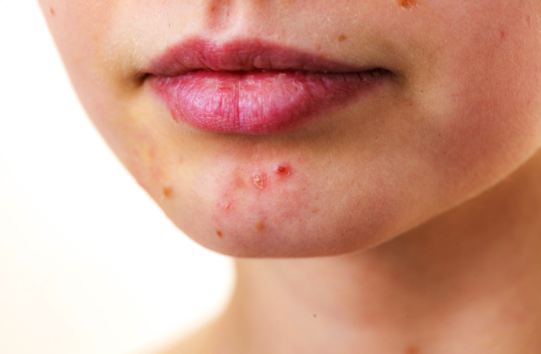Acne is caused by a variety of factors. These factors include increased p. acnes bacteria, increased oil production by oil glands, “clogged pores,” genetic susceptibility, and increased androgen hormones. It is important to target multiple causes of acne to best control it. There are many “tried and true” options and some newer and less well known treatment options.
Initial treatment options for mild to moderate acne focus on consistent application of topical products.
Face washes should contain an active ingredient against acne. Examples include benzoyl peroxide and salicylic acid. After washing the face, topical retinoids are used. Prescription retinoids such as retin-A and tretinoin increase cell turnover and prevent “clogged pores.” Retinoids work best against comedonal acne which refers to whitehead and blackhead acne. Retinoids are a staple of acne management and are also a popular anti-aging product as they improve skin texture and fine lines.
Antibiotics are another cornerstone of acne management- especially inflammatory acne. Inflammatory acne usually appears as red bumps or nodules. Topical and oral antibiotics reduce p. acnes bacteria and reduce inflammation leading to acne lesions. These are usually used in conjunction with topical retinoids.
Hormones contribute to acne because androgens stimulate the oil glands to produce more oil. Oil rich environments allow p. acne bacteria to thrive and cause more acne breakouts. Females who break out during their menstrual cycle or primarily have bumps and nodules along their jawline often respond to hormonal therapies including oral contraceptives and oral spironolactone. Unfortunately, these options are not available to males. However, a new drug, Winlevi, offers a topical antiandrogen option for both males and females.
The ultimate acne treatment is isotretinoin, previously known by a brand name, “Accutane.” Some patients may be nervous about isotretinoin because it is highly regulated due to causing birth defects in pregnant women. However, it is usually well tolerated and is extremely effective at eliminating active acne. Isotretinoin is also the only medication shown to cause long term remission of acne.
The above options can control acne well, but it can be frustrating when there are breakthrough lesions. Some additional options for breakthrough lesions include chemical TCA peels (VIPeels), vascular laser (V-beam laser) treatments, and steroid (kenalog) injections.
VIPeels are a chemical peel that include anti-acne ingredients such as salicylic acid and benzoyl peroxide to promote cell turnover and reduce inflammation and hydroquinone to lighten acne scarring.
V-beam and Kenalog can be used to spot treat a stubborn or inflamed lesion. V-beam is a laser that delivers energy to kill active acne bacteria or treat red scars left behind by previous acne lesions. Kenalog is a steroid that is injected directly into an acne lesion to reduce inflammation. Kenalog is especially useful before a big event because it works quickly, usually reducing a lesion within 24-48 hours. Kenalog is also useful to treat hypertrophic or keloid scars from cystic acne.
With so many options available, it is important to meet with a provider to discuss which option(s) are best for you.

